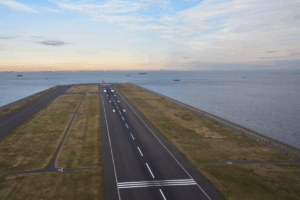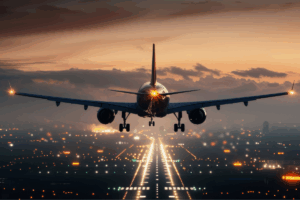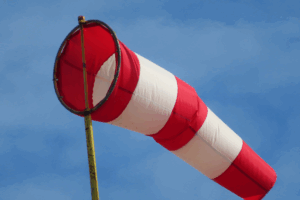Cuando los aeropuertos comerciales empezaron a funcionar a principios del siglo XX, los sistemas de iluminación de las pistas solían consistir en bengalas de queroseno, balizas y focos para señalizar la zona de aterrizaje. Por aquel entonces, los operadores aeroportuarios utilizaban lo que tenían a mano para garantizar la seguridad y la eficacia del despegue y el aterrizaje de los aviones.
En los aeropuertos modernos de hoy en día, la tecnología avanzada se ha convertido en un elemento indispensable de los sistemas de iluminación de las pistas de aterrizaje y despegue. Un ejemplo clave de una innovación en la que los pilotos confían durante la aproximación es el indicador de precisión de la trayectoria de aproximación (PAPI).
Estas unidades son tan eficaces para mejorar la seguridad en las pistas de los aeropuertos que tanto la Administración Federal de Aviación (FAA) como la Organización de Aviación Civil Internacional (OACI) exigen el uso de sistemas PAPI en la mayoría de los aeropuertos comerciales.
En el blog de este mes, desvelamos qué hacen las unidades PAPI, cómo funcionan y por qué su aeropuerto necesita disponer de unidades PAPI operativas.
Cómo funcionan los sistemas indicadores de trayectoria de aproximación de precisión
Una unidad PAPI es una serie de dispositivos luminosos instalados junto a la pista. Los aeropuertos más grandes suelen utilizar cuatro unidades de iluminación alineadas en una sola fila, mientras que algunos aeródromos más pequeños utilizan tan solo dos unidades de iluminación.
Cada luminaria PAPI emite un haz dividido en dos zonas de color: blanco en la parte superior y rojo en la inferior. Los pilotos ven una mezcla de estos colores que indican su ángulo de aproximación actual:
- La aparición de más luces blancas que rojas indica una aproximación demasiado alta
- La aparición de más luces rojas que blancas indica una aproximación demasiado baja
- Dos luces blancas y dos rojas indican la aproximación de planeo correcta

Es un sistema sencillo que proporciona una señal visual inmediata a los pilotos. A diferencia de los instrumentos de la cabina, que requieren tiempo para ser interpretados, los PAPI proporcionan una confirmación directa de la altitud de descenso del avión, lo que permite realizar correcciones en tiempo real en momentos críticos.
¿Cuáles son las ventajas de instalar indicadores de precisión de la trayectoria de aproximación en los aeropuertos?
La aproximación y el aterrizaje se encuentran entre las fases más difíciles del vuelo, especialmente durante las inclemencias meteorológicas, los periodos de baja visibilidad o cuando las pistas están rodeadas de obstáculos. Las unidades PAPI ayudan a mitigar el riesgo de accidentes:
- Ayudar a los pilotos a evitar sobrepasar o sobrepasar el umbral de la pista.
- Confirmación visual coherente, incluso cuando fallan los instrumentos de la cabina o se interrumpe la señalización.
- Evitar el vuelo controlado hacia el terreno (CFIT) manteniendo la aeronave alineada con la pendiente de planeo segura.
- Permite a los pilotos obtener una verificación instantánea de la trayectoria de un vistazo en lugar de tener que comprobar varios instrumentos, lo que les permite prestar más atención a otras tareas críticas, como controlar la velocidad aerodinámica, los vientos cruzados o la separación del tráfico.
Aunque aportan importantes ventajas de seguridad a los aeropuertos, los PAPI también ofrecen otros beneficios cruciales que mejoran las operaciones:
- Permite aterrizajes precisos en condiciones meteorológicas y de visibilidad variables, aumentando la capacidad efectiva de la pista.
- Reduce la frecuencia de las maniobras y los aterrizajes abortados, manteniendo las operaciones dentro de los plazos previstos.
- Ayuda a mitigar los riesgos de accidentes causados por errores de aproximación que dan lugar a largos procesos de investigación y litigios.
- Mejora la reputación de un aeropuerto en cuanto al cumplimiento de la normativa y la inversión proactiva en seguridad cuando los sistemas PAPI se instalan y mantienen correctamente.
- Utiliza tecnología LED que consume menos energía, minimiza el tiempo de inactividad de las pistas para el personal de mantenimiento y requiere menos cambios de bombillas que sus predecesoras halógenas, lo que supone un importante ahorro de costes para los operadores aeroportuarios.
- Se integra fácilmente con los sistemas avanzados de control y supervisión de la iluminación (ALCMS), que ofrecen a los operadores visibilidad y control centralizados, incluida la capacidad de ajustar automáticamente el brillo del haz del PAPI en función de las condiciones de visibilidad.
Más información: 5 puntos esenciales para actualizar el sistema de iluminación de las pistas de aterrizaje y despegue
Aumente la seguridad de los aeropuertos con la iluminación LED indicadora de precisión de la trayectoria de aproximación (PAPI) L-880(L)/L-881(L)
Cuando desee actualizar o ampliar su sistema de pistas con un PAPI de alta calidad que utilice tecnología LED, la unidad L-880(L)/L-881(L) ofrece la solución perfecta.
Este sistema PAPI ofrece un rendimiento fotométrico fiable mediante bombillas LED que proporcionan más de 150.000 horas de servicio. Las unidades son compactas y ligeras, e incorporan una pantalla LED digital que indica el estado sin necesidad de abrirlas. También son fáciles y rápidas de mantener, ya que no requieren un banco óptico ni herramientas especiales para su mantenimiento.
La unidad L-880(L)/L-881(L) establece el estándar de seguridad avanzada en pista, eficiencia y rentabilidad, ofreciendo la precisión, durabilidad y fiabilidad que los aeropuertos necesitan para proteger a pilotos, pasajeros e infraestructuras aeroportuarias.
Si tiene alguna pregunta sobre por qué su aeropuerto debería invertir en tecnología PAPI, póngase en contacto con los expertos de Airport Lighting Company para obtener un servicio rápido y amable. Siempre nos complace poner en contacto a nuestros clientes con soluciones personalizadas que mejoren la seguridad, la eficiencia y la rentabilidad de sus operaciones.
Llame al Airport Lighting Company para conocer lo último en tecnología de iluminación de aeropuertos
El equipo Airport Lighting Company es a su disposición para responder a sus preguntas sobre cómo nuestros productos tecnológicos pueden ayudarle a mejorar la seguridad, fiabilidad y eficacia de sus pistas. Llame al 315-682-6460 para obtener un servicio rápido y amable en el que puede confiar.


